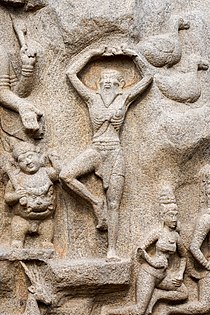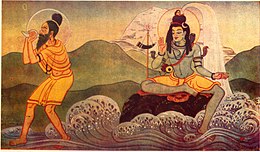Bhagiratha (Sanskrit: भगीरथ, IAST: Bhagīratha) is a legendary king of the Ikshvaku dynasty in Hindu literature. He is best known for his legend of bringing the sacred river Ganges, personified as the Hindu river goddess Ganga, from heaven upon the earth, by performing a penance.[2]
| Bhagiratha | |
|---|---|
 Sculpture of Bhagiratha's penance, Descent of the Ganges, Mahabalipuram | |
| Texts | Ramayana, Mahabharata, Puranas |
| Region | Ayodhya |
| Genealogy | |
| Parents |
|
| Children | Śruta (son), Haṃsī (daughter) |
| Dynasty | Suryavamsha |

Legend
editBhagirathaprayatnam
editKing Sagara, the great-grandfather of Bhagiratha, once performed the ashvamedha sacrifice, but the sacrificial horse was stolen by Indra. The deity had the animal sequestered in Patala, where Sage Kapila was performing a penance. The 60,000 sons of Sagara discovered the horse in Patala, whereupon they disturbed Kapila with their hoarse noises. Infuriated, the 60,000 sons of Sagara were reduced to ash by the fiery eyes of the sage. The responsibility of performing the funeral rites of these sons passed down from generation to generation, until it was acquired by Bhagiratha, who upon his ascension to the throne of Ayodhya, went to practice austerities in the Himalayas, to invoke the goddess Ganga. Ganga told Bhagiratha that were she to descend from Svarga to the earth, the force of her fall would be difficult to sustain. She asked him to obtain the favour of the matted-haired, blue-throated deity Shiva, as no one except him would be able to sustain her. Heeding her words, the king then performed a penance that lasted for a millennium for Shiva at Kailasa, and sought his cooperation in allowing Ganga to flow through his hair. Shiva granted him the boon, and stood in position, even as the torrent of Ganga's stream rushed upon his hair. Ganga flowed along the matted hair of Shiva for a thousand years. Bhagiratha performed another penance to please Shiva, until the deity shook his hair and allowed a single drop to descend upon the Indo-Gangetic plain, which became the Ganges. For Bhagiratha, the river flowed along the plain to Patala, and performed the funeral rites of Sagara’s sons.[3] This episode is referred to as Bhagīrathaprayatnam, literally meaning, "Bhagiratha's labour".[4][5]
To commemorate his efforts, the head stream of the river is called Bhagirathi by locals, till it meets the Alaknanda river at Devprayag.[6] The mythical pātāla where the sage Kapila meditated is identified with the Sāgar Island, at the confluence of the Bhagirathi stream of the Ganges (flowing by Kolkata and revered as Ganga) and the Bay of Bengal. The sea (sam-udra) is called Sāgara in honour of Bhagiratha's ancestor the King Sagara. Kapila's ashrama is located at Sagar Island and hosts the annual Ganga Sagar Mela and bathing rituals on Makara Sankranti day every year.
While flowing towards Patala, the Ganga flooded the ashrama of Sage Jahnu. To punish the haughtiness of the goddess, the sage swallowed the river. It was with the insistent entreaties of Bhagiratha that the sage consented to push the river out through his ear, which offered the goddess the epithet Jahnavi.[7][8]
Reign
editAfter completing the funeral rites of his ancestors, Bhagiratha governs once more as king, and his people were wealthy and prosperous under his reign.[9]
The Mahabharata states that the king had a great efficacy of gifting cows, offering hundreds of thousands of cows and their calves to the sage Kohala.[10]
He marries his famous daughter, Haṃsī, to the sage Kautsa, before departing the earth.[11]
Literature
editNarada Purana
editIn the Narada Purana, King Bhagiratha appeases Yama, and holds a discussion with him regarding the nature of righteousness. Yama offers the king various modes of being righteous, including offering employment and donating wealth to Brahmins, building Vishnu and Shiva temples, rituals that should be performed for the aforementioned two deities, donating food to the hungry, and the acquisition of punya. Yama goes on to describe the nature of sin, as well as the various hells that exist. The deity instructs the king to worship Vishnu, who is the equivalent of Shiva, and informs him of his future of freeing his ancestors from Naraka by causing the descent of the Ganga.[12]
Bengali literature
editIn most accounts of Bhagiratha, he is born to his father Dilipa and his unnamed mother in an unremarkable fashion.[citation needed] However, a number of Bengali accounts tell how Dilipa dies without begetting an heir.[citation needed] This story may first be attested in the Bengali-script recension of the Sanskrit Padma Purana; it recurs in the influential, probably fifteenth-century CE Bengali Krittivasi Ramayan, and thereafter in other texts from Bengal such as Bhavananda's Harivansha, Mukundarama Chakravartin's Kavikankanachandi, and the sixteenth-century Ramayana by Adbhutacharya.
Dilipa's lack of an heir troubles the gods, because it has been prophesied that Vishnu will be born to Dilipa's line, and this prophecy cannot come true unless Dilipa has a child. Therefore, through the advice of a sage or god, two of Dilipa's widows have sex with one another and in this way one gets pregnant and gives birth to Bhagiratha. However, the baby is deformed (in the Padma Purana version, for example he is boneless, while in the Krittivasi Ramayan he is merely a lump of flesh) until he encounters the crippled sage Ashtavakra, who transforms him into a beautiful, strong child/youth. The Krittivasi Ramayan even goes on to describe Bhagiratha being bullied at school for having two mothers rather than heterosexual parents. Some of the texts too use the story to provide a folk-etymology for Bhagiratha's name, claiming that it comes from bhaga ('vulva').[13][14][15][16]: 146–60 [17]
Gallery
editA sculpture of Bhagiratha can be seen beneath the spout of almost every dhunge dhara (hiti) or tutedhara (jarun, jahru, jaladroni), two types of drinking fountain found in the old settlements of Nepal. Bhagiratha is pictured sitting, standing or dancing while holding or blowing a conch. A similar figure can be seen below the gargoyles in some temples in India.[18]
-
Bhagiratha beneath the main spout of Sundhara, Kathmandu, Nepal
-
Bhagiratha on a jarun of Nag Pokhari, Bhaktapur, Nepal
-
Bhagiratha beneath the stone spout of Lamugah Hiti, Bhaktapur, Nepal
-
Bhagiratha on a jarun at Taumadhi Square, Bhaktapur, Nepal
-
Bhagiratha beneath a gargoyle at the Brihadisvara Temple, Thanjavur, India
-
Shiva Gangadhara, Parvati, Bhagiratha (left) at the Ravana Phadi Cave, Aihole, India
-
Bhageeratha statue in Hyderabad, India
See also
editReferences
edit- ^ Ruth Vanita (2005). "Disability as Opportunity Sage Ashtavakra Mentors Bhagiratha, the Disabled Child of Two Mothers". Gandhi's Tiger and Sita's Smile: Essays on Gender, Sexuality, and Culture. Yoda Press. ISBN 9788190227254.
The story of Bhagiratha's birth to two women occurs, as far as I know, only in texts produced from the fourteenth century onwards in Bengal. Other manuscripts of the Sanskrit Padma Purana, in the Devanagari script, and other Puranas too relate that Bhagiratha was born in the regular way to his father, Dilipa. As is standard in patrilineages, these latter texts do not mention his mother's name.
- ^ Edits, The Divine (2023-04-22). Padma Purana - A Concise Guide. by Mocktime Publication. p. 10.
- ^ Parmeshwaranand, Swami (2001). Encyclopaedic Dictionary of Puranas. Sarup & Sons. p. 161. ISBN 978-81-7625-226-3.
- ^ Thomas, Paul (1955). Epics, Myths and Legends of India: A Comprehensive Survey of the Sacred Lore of the Hindus, Buddhists and Jains. D.B. Taraporevala. p. 102.
- ^ Mani, Vettam (2015-01-01). Puranic Encyclopedia: A Comprehensive Work with Special Reference to the Epic and Puranic Literature. Motilal Banarsidass. p. 114. ISBN 978-81-208-0597-2.
- ^ Lochtefeld, James G. (2002). The Illustrated Encyclopedia of Hinduism: A-M. Rosen. pp. 95–96. ISBN 978-0-8239-3179-8.
- ^ Mankodi, Kirit (1973) "Gaṅgā Tripathagā"Artibus Asiae 35(1/2): pp. 139-144, p. 140
- ^ "The Mahabharata, Book 3: Vana Parva: Tirtha-yatra Parva: Section CVIII". www.sacred-texts.com. Retrieved 2019-04-14.
- ^ Vālmīki (1952). The Ramayana of Valmiki. Shanti Sadan. p. 89. ISBN 978-0-85424-048-7.
- ^ The Mahabharata. Bharata Press. 1893. p. 621.
- ^ Mani, Vettam (2015-01-01). Puranic Encyclopedia: A Comprehensive Work with Special Reference to the Epic and Puranic Literature. Motilal Banarsidass. p. 115. ISBN 978-81-208-0597-2.
- ^ Chaturvedi, B. K. (2015-01-23). Narada Purana. Diamond Pocket Books Pvt Ltd. p. 24. ISBN 978-81-288-2812-6.
- ^ Ruth Vanita, '"Wedding of Two Souls": Same-Sex Marriage and Hindu Traditions', Journal of Feminist Studies in Religion, 20.2 (Fall, 2004), 119-35.
- ^ Ruth Vanita, 'Disability as Opportunity: Sage Ashtavakra Mentors Bhagiratha, the Disabled Child of Two Mothers', in Gandhi's Tiger and Sita's Smile: Essays on Gender, Sexuality and Culture (New Delhi: Yoda, 2005), pp. 236-50; ISBN 81-902272-5-4.
- ^ Ruth Vanita, 'Born of Two Vaginas: Love and Reproduction between Co-Wives in Some Medieval Indian Texts', GLQ: A Journal of Lesbian and Gay Studies, 11 (2005), 547–77, doi:10.1215/10642684-11-4-547.
- ^ Ruth Vanita, Love's Rite: Same-Sex Marriage in India and the West (New York: Palgrave Macmillan, 2005).
- ^ Ruth Vanita, 'Naming Love: The God Kama, the Goddess Ganga, and the Child of Two Women', in The Lesbian Premodern, ed. by Noreen Giffney, Michelle M. Sauer, and Diane Watt (New York: Palgrave Macmillan, 2011), 119-30; ISBN 978-1-349-38018-3 doi:10.1057/9780230117198.
- ^ Water Conduits in the Kathmandu Valley (2 vols.) by Raimund O.A. Becker-Ritterspach, ISBN 9788121506908, Published by Munshiram Manoharlal Publishers Pvt. Ltd., New Delhi, India, 1995
Sources
edit- The Ramayana (2001) by Ramesh Menon
- Dictionary of Hindu Lore and Legend (ISBN 0-500-51088-1) by Anna L. Dallapiccola